![THE STORM [home page]](../art/p_title.gif)

A timeline of the warnings, some of the decisions leading up to the disaster, and what went wrong with the government's response. [Note: The information in this timeline is drawn from the news and government agencies' reports, as published daily during the crisis, and from FRONTLINE's research and reporting.]
Wednesday, August 24 |
"Tropical Depression 12"
A Tropical Depression with 35 mph maximum sustained winds is located 250 miles east-southeast of southeast Florida. By the end of the day, it is upgraded to Tropical Storm Katrina, with 50 mph maximum sustained winds. A hurricane warning is issued for the Southeast Florida coast.
FEMA National Situation Update:
"A close eye will be kept … this system could strengthen … "
|
|
Thursday, August 25 |
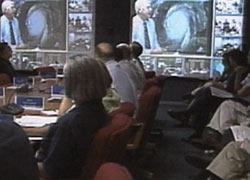
Monitoring Katrina's approach.
"Hurricane Katrina"
Katrina becomes a Category 1 hurricane with 75 mph maximum sustained winds. At 7 pm it makes landfall north of Miami.
FEMA National Situation Update:
"Media reports attribute Katrina with four fatalities [in Florida], … more than a million customers were without electricity…"
|
|
Friday, August 26 |
"New Orleans is of Particular Concern"
Hurricane Katrina becomes Category 2 by 11 am, with 100 mph maximum sustained winds. It is 45 miles northwest of Florida Keys.
FEMA National Situation Update:
"Katrina will regenerate on Friday over Gulf of Mexico, head west-northwest … then turn northward. Mississippi and Louisiana governors declare states of emergency. In Louisiana, New Orleans is of particular concern because much of that city lies below sea level. …"
Note: The Earlier Warnings -- In 2001, FEMA identified the three most likely disasters facing the U.S.: an earthquake in California, a hurricane in New Orleans and a terrorist attack in New York City. And, in 2004, FEMA sponsored a disaster planning exercise in which the scenario was a major hurricane striking New Orleans. It was called "Hurricane Pam" and the exercise was conducted with state and local emergency managers.
|
|
Saturday, August 27 |
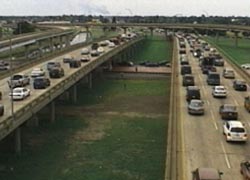
Residents evacuating New Orleans.
"The Storm is Headed Right for You…"
Katrina becomes a Category 3 with 115 mph maximum sustained winds. By the end of the day it is 335 miles from the mouth of the Mississippi River. The expected storm surge is 15 to 20 feet, locally as high as 25 feet.
FEMA Situation Update:
"Coastal residents jammed freeways and gas stations as they rushed to get out … A direct hit could wind up submerging New Orleans in several feet of water … At least 100,000 people in the city lack transportation to get out ... Louisiana and Mississippi make all lanes northbound on interstate highways..."
National Hurricane Center director Max Mayfield tells the Times-Picayune newspaper, "This is scary … this is the real thing." A Louisiana State University computer model of a 115 mph storm strike shows the overtopping of levees protecting New Orleans and nearby areas. New Orleans Mayor Ray Nagin says he'll follow the state evacuation plan and will not call for mandatory evacuation until 30 hours before projected landfall. He also announces that the Superdome will be "a shelter of last resort for evacuees with special needs." Some parishes order mandatory evacuations.
Read the full interview »
Ray Nagin, mayor of New Orleans:
"I got a call, I think Saturday afternoon … [from] Max Mayfield, the hurricane director. And he said definitively, "Mr. Mayor, the storm is headed right for you. I've never seen a hurricane like this in my 33-year career. And you need to order mandatory evacuation. Get as many people out as possible."
At that time, I thought we had done a pretty good job because we had gotten about 80 percent of the people out. … I immediately hung up the phone, called my city attorney … because they had always advised that you can't do a mandatory evacuation. And I said, "We're doing one in the morning."
Read the full interview »
Kathleen Blanco, governor of Louisiana:
She requests President Bush to declare a state of emergency in Louisiana.
"I went into New Orleans ... and stood beside Mayor Nagin and emphasized the need to leave. I gave people clues on how to pack. … And we said, "Plan your route carefully. Pack carefully. Pack as though you're going on a camping trip. Bring enough to sustain yourself, your family, your children. …"
Read the full interview »
Michael Brown, FEMA director:
"I at least wanted a mandatory evacuation of New Orleans and the surrounding parishes [on Saturday]. We've all feared a catastrophic hurricane striking New Orleans. That is why the first place we picked to do an exercise and planning was New Orleans. And based upon that ["Hurricane Pam" planning exercise], I knew they needed to evacuate. …"
|
|
Sunday, August 28 |
"Category 5"
At 7 am Katrina is a Category 5 with 160 mph maximum sustained winds. It is 250 miles south-southeast of the mouth of the Mississippi River. A hurricane warning is issued for north central Gulf Coast including New Orleans. By the end of the day, the projected storm surge is 18 to 22 feet, locally as high as 28 feet.
National Oceanic and Atmospheric Administration warning:
"Most of the area will be uninhabitable for weeks ... perhaps longer. At least one half of well constructed homes will have roof and wall failure. … The majority of industrial buildings will become non functional. … Airborne debris will be widespread and may include heavy items such as household appliances and even light vehicles. … Persons, pets, and livestock exposed to the winds will face certain death if struck. Power outages will last for weeks … water shortages will make human suffering incredible by modern standards."
Around 9:30 a.m. Mayor Ray Nagin issues a mandatory evacuation. The city's buses have been positioned around the city in locations that have never been flooded.
The Times-Picayune reports that an estimated 112,000 people do not own cars. Rapid Transit Authority buses pick up citizens and bring them to the Superdome, where the Louisiana National Guard has stocked enough MREs to feed 15,000 people for three days. By the end of the day, there are 30,000 people at the Superdome. The Coast Guard mobilizes to respond after the storm hits. Several parishes and the city of New Orleans announce emergency responders will stop venturing out once the wind exceeds 45 mph.
Read the full interview »
Michael Brown, FEMA director:
"I realized how serious things were on Sunday. We do our video conference calls before and during disasters. And I forget whether it was on Saturday or Sunday, I told my staff that I was sick to my stomach because I could see that some things weren't looking quite right. And that this could potentially be the big one that we had planned for in Hurricane Pam."
Note: In the last hours before Katrina made landfall, dozens of copies of the Hurricane Pam report are distributed to emergency planners.
|
|
Day One | Monday, August 29 |
"Landfall"
Around 6 a.m., Category 4 Hurricane Katrina strikes the Gulf Coast with 145 mph maximum sustained winds. Around 8 a.m. the storm's eye passes eastern New Orleans. There is a belief that the city has avoided a direct hit. But by late morning, when FEMA director Michael Brown arrives in Baton Rouge, water is already coming over levees in the 9th Ward and there are reports of breaks in the Industrial Canal and 17th Street Canal levees.
The storm has ripped a hole in the Superdome where the power has gone out. Floodwaters keep rising. Winds continue to damage or destroy buildings and blow out windows. The Louisiana National Guard's Jackson Barracks flood. They spend the next 24 hours trying to save themselves.
President Bush declares Louisiana and Mississippi major disaster areas.
Interstate 10 is shut down with damage to 40 percent of its Twin Span Bridge over Lake Ponchartrain. Phone service and electricity to some 770,000 people in the area is cut off. Flooding grows as water surges over levee breaks from Lake Ponchartrain; the 9th Ward is almost entirely submerged. Reports stream in from people needing rescue. Rescuers drop them off wherever there is high ground; many are dropped at interstate overpasses and the Superdome. Looting breaks out in parts of the city.
Read the full interview »
Walter Maestri, Jefferson Parish emergency manager:
"… After Katrina passed, we thought we're pretty much out of the woods. … Within five hours I start to get reports from my staff members, who are out doing assessments, the water's rising. … We knew we were gonna have to shelter people. We began search-and-rescue missions using local state resources, waiting for the federal cavalry to arrive and believing that it would be here in 48 to 60 hours.
Read the full interview »
Michael Brown, FEMA director:
"I remember reading [that New Orleans had dodged a bullet]. And I knew it wasn't true, because 8:00 or 10:00 that morning, I received a report from one of my staffers that either a levee had been topped or had actually broken.
I went to the Adjutant General [Landreneau] and I went to Gov. Blanco and said, 'We've got to move National Guard troops in there. We have got to start getting people out.' … I said, 'We need to do this.' And nothing happened."
Read the full interview »
Leo Bosner, FEMA watch officer:
"…We're all looking at each other like, 'Why aren't we getting orders to move on this? … Why haven't the bosses decided to move the people out?' And they hadn't. We'd sent them all the information they needed. Here's a [powerful] hurricane. Here's all these thousands of people that don't have any way to get out of the city. And the bosses say, 'Oh, okay. We'll put a couple of medical teams on standby.'"
Read the full interview »
Mayor Ray Nagin
"[Michael] Brown I did not see the first couple of days. The only person I saw from FEMA was basically this guy named Marty [Bahamonde]. …[He] came on site, I think it was Monday after the event. And he had flown in a helicopter. And he was the first guy that told us about the amount of devastation and the levee breaches. … And he basically asked me, 'Mr. Mayor, what do you need?' And I had a piece of paper where I wrote down like a five-point plan of the things that we needed to do. I laid that out for him. ... Then we kind of figure out ways that we could coordinate. And then he was gone after a while."
|
|
Day Two | Tuesday, August 30 |

A New Orleans house submerged in floodwaters.
"A Very Dynamic Situation"
The Army Corps of Engineers attempts to plug breaches in the 17th Street Canal and Industrial Canal levees. Its efforts fail. The city floods further.
Hundreds of people already have been rescued. At daybreak, rescuers set out on boats to help others still stranded. By afternoon, officials issue a citywide call for more boats to help. Throughout the day, emergency responders and public officials complain that communication links are very poor.
Looting becomes more widespread; hotels begin turning out guests. People begin arriving at the Ernest M. Morial Convention Center seeking shelter, food, and water. People continue to head towards the Superdome, which is now surrounded by water. Reports put the population there in the tens of thousands. Conditions are deteriorating with bathrooms overflowing, no power for air conditioning and little food and water. Gov. Blanco tours the area Tuesday evening and announces that the Superdome should be evacuated.
Read the full interview »
Gov. Kathleen Blanco:
"We did meet with [Mayor Nagin] Tuesday morning. Flew into the city. Met in the little office at the Super Dome where the heliport is. And [FEMA Director] Michael Brown was with me at that time. And the mayor … began to tell us some of the things that he needed. And Michael Brown was there listening. And it was a very good meeting, I thought. We knew what had to be done. … But more and more people were being evacuated from their rooftops after being in the sun for long periods or overnight and being put on highways on high ground…. so you had a very dynamic situation."
Read the full interview »
Michael Brown, FEMA director:
"At that stage, we had mission-assigned the Department of Defense to start giving us everything they could in terms of air-lift capability.
I was able to get Governor Blanco to sit with me several times in the office that she had and talk about what needed to be done. … I just expressed to her my concern about the lack of unified command, and the need to have more of a structure of what was going on. … We had pre-positioned supplies, medical teams, Meals Ready To Eat, and food in the Superdome. I think the American Red Cross already had shelters and was already feeding people. FEMA was doing what it's supposed to be doing."
Read the full interview »
Leo Bosner, FEMA watch officer:
"… from my view sitting inside a windowless room at FEMA headquarters during my nightshift … we are working to coordinate with our federal partners, to get water out. To get food out. To get medical teams and search teams out the door and get 'em down there. Now, other than media reports, I don't know what's happening at the other end. I've heard some terrible stories since that the stuff wasn't getting there. But we were working frantically to get it out."
Read the full interview »
Mayor Ray Nagin:
"I was told that they could mobilize immediately 2,500 National Guards members. All I can tell you is that in the city of New Orleans we had maybe 250 guardsmen that we could account for…. "[I] got to the president. Expressed my concerns, my frustration …He needed to really get us resources to save people. I had all the police, the firefighters in rescue mode, so the looting thing started to rear its head. And I said [to the president], "Here's my piece of paper. Here's the things I think we need to focus on. And we need to get these people out of the Superdome because it's a shelter of last resort, and they only have a limited amount of resources."
|
|
Day Three | Wednesday, August 31 |
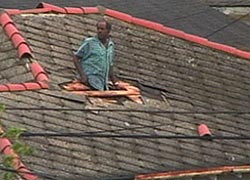
New Orleans resident climbing through roof of house.
"We Should Have Asked Sooner"
Gov. Blanco announces New Orleans must be evacuated because of the still- rising water and uninhabitable conditions. Mayor Nagin estimates 50,000 to 100,000 people remain in the city. Rescue efforts are delayed because of the inability of rescuers to communicate with each other. Virtually all communication systems are out.
City officials say 80 percent of New Orleans is flooded. FEMA organizes 475 buses to be sent in to transport many of the estimated 23,000 people from the Superdome to the Houston Astrodome. Newly rescued people are still being brought to the Superdome. Widespread looting continues. Evacuating hospitals is a top priority: Patients and staff are stranded and supplies and power are dwindling.
By midday, water levels between the city and Lake Ponchartrain have equalized. The Army Corps of Engineers renews work to fix the breach in the 17th St. Canal. President Bush flies over the area on his way back to Washington. He announces FEMA is moving supplies and equipment into the hardest hit areas.
Read the full interview »
Gov. Kathleen Blanco:
"All I know is on Wednesday night I was convinced that there were no FEMA buses. I began to believe that no buses had been ordered. We were moving school buses in. But they're designed for short hauls."
Read the full interview »
Walter Maestri, Jefferson Parish emergency manager:
"What we did -- under Louisiana law the parish presidents, the head of the counties, have the authority to use private resources. In all honesty, we begin looting. We go to Sam's and Wal-Mart and Winn-Dixie and gather up food and water and start distributing it because we had 60 hours' worth of resources that we had stored, but now we're out of it.
…When we didn't get any assistance from the state or from FEMA in the time period that we thought was appropriate, I got someone in an automobile and said, 'Go to Baton Rouge, go find out. I've got to know. Go up there, face to face and say, "What is happening here? Where is water? Where is food? Where is all the things that we need to get out of here?"' And he passes, literally, hundreds of school buses lined up to come and get these folks. But the problem was that because of the fear that resulted from the civil unrest, the bus drivers said, 'We're not going in there to pick these people up unless you put a law enforcement official on every one of the buses, because we're afraid.'"
Read the full interview »
Michael Brown, FEMA director:
"As I have said, I think that one of the biggest mistakes that I made as the FEMA director during Katrina was not immediately turning to the military and saying: 'We have been overwhelmed. We need you to take over logistics, distribution of commodities, etc.'
We immediately did turn to the military and mission-assigned them to start doing airlifts, start bringing things in. The mistake that I made was not doing that sooner and not giving them the orders that we needed them to do all of that immediately. … [Governor Blanco] probably should have asked sooner. I probably should have asked sooner. I think we both should have asked sooner."
|
|
Day Four | Thursday, September 1 |
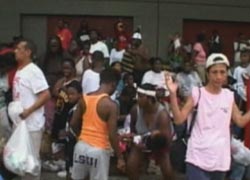
People outside the Convention Center.
"Press Conferences v. Reality"
The Department of Defense's "Joint Task Force Katrina" -- 4,600 active-duty military headed by Army Lt. Gen. Russel Honoré -- sets up at Camp Shelby, Miss. to support FEMA disaster relief efforts, but it will be two days before the troops arrive in the city. Some 11,000 National Guardsmen are now on duty in Louisiana and increased security begins to have an effect on lawlessness in New Orleans, although some violence continues.
Buses have started evacuating people at the Superdome, but at the Convention Center thousands are still waiting and conditions continue to deteriorate there. Television reporters, live on the scene at the Convention Center, report on the growing crisis. In television interviews, Michael Brown, FEMA director, states that he only just heard about the suffering at the Convention Center, when in fact, he tells FRONTLINE, he misspoke; he was told the previous day about the situation.
At a press conference in Baton Rouge, 80 miles away, Gov. Blanco says, "Mr. President, thank you thank you, thank you. You have responded to my calls." Michael Chertoff, secretary of the Department of Homeland Security, says he is "extremely pleased with the response of every element of the federal government and federal partners ... to this terrible tragedy." And Michael Brown tells Louisiana officials, "What I've seen here today is a team that is very tight knit, working closely together, being very professional ... and making the right calls."
But Mayor Nagin goes on radio and castigates state and federal officials for their inaction and demands they "fix the biggest god-damn crisis in the history of this country." And Michael Brown tells FRONTLINE that in order to quell panic, he misled the public in saying that everything was going fine at the local level.
Read the full interview »
Michael Brown, FEMA director:
"I'm not gonna go on television and publicly say that I think that the mayor and the governor are not doing their job, and that they don't have the sense of urgency. I don't think that's the proper thing to do.
Producer Martin Smith: So, although you said that, you didn't feel that way at that time?
Oh, absolutely not. I'm just not going to go on, on public television and bash in the middle of a disaster what I think people should or should not be doing."
|
|
Day Five | Friday, September 2 |
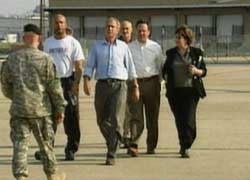
President Bush arrives in Louisiana. Left to right: Mayor Ray Nagin, President Bush, Homeland Security Secretary Michael Chertoff, FEMA Director Michael Brown, Gov. Kathleen Blanco
"A Meeting on Air Force One"
Several thousand National Guard troops start reaching the thousands of evacuees at the Convention Center and elsewhere. President Bush arrives in New Orleans and holds a meeting on Air Force One with federal and local officials.
FEMA Situation Update:
"To cries of 'Thank you, Jesus!' and catcalls of 'What took you so long?,' a National Guard convoy packed with food, water and medicine rolled through axle-deep floodwaters Friday into what remained of New Orleans and descended into a maelstrom of fires and floating corpses. … More than four days after the storm hit, the caravan of at least three-dozen camouflage-green troop vehicles and supply trucks arrived along with dozens of air-conditioned buses to take refugees out of the city. … In what looked like a scene from a Third World country, some people threw their arms heavenward and others nearly fainted with joy as the trucks and hundreds of soldiers arrived in the punishing midday heat. But there were also profane jeers from many in the crowd of nearly 20,000 outside the Convention Center, which a day earlier seemed on the verge of a riot, with desperate people seething with anger over the lack of anything to eat or drink. …
"Law and order all but broke down in New Orleans over the past few days. Storm refugees reported being raped, shot and robbed, gangs of teenagers hijacked boats meant to rescue them, and frustrated hurricane victims menaced outmanned law officers. Police Chief Eddie Compass admitted even his own officers had taken food and water from stores. Officers were walking off the job by the dozens. …"
Read the full interview »
Gov. Kathleen Blanco:
"[On Air Force One] we gave the president a briefing on everything that had gone on. And Mayor Nagin expressed his concerns. We all did. [Mayor Nagin] was upset with everything. He didn't even know what efforts had been made on his behalf because he had no lines of communications open to him. He didn't care where the help came from, he just wanted it to be there. …That's the attitude I would take if I was operating in the dark too. …"
Read the full interview »
Mayor Ray Nagin:
"They invited me to Air Force One ... There's this lunch. … [Secretary of Homeland Security Michael] Chertoff is there. And the president comes, and we have this meeting. … Blanco is there. Her husband [Raymond Blanco] is there. [Congressman] Bobby Jindal is there, the senators Landrieu and [David] Vitter, and Congressman [William] Jefferson. And then they'd gone around the room, and everybody's talking to the president and giving their opinions. And then finally I just stopped and said: 'Excuse me, but time is of the essence. With all due respect, Mr. President, if you and the governor don't get on the same page, this event is going to continue to spiral down, and it's going to be a black eye on everybody -- federal, state and local.' And there seems to be this dance about who has ultimate authority.
Producer Martin Smith: Were they going back and forth with each other?
No, they weren't. They were very civil and very cordial.
Producer Martin Smith: So we're just eating sandwiches and making nice while people are stranded on rooftops?
They were making suggestions about we need to do this and that. ... And I wanted to cut to the chase because I knew what the real issue was. And in my opinion, it was this whole 'who has ultimate authority' and whether the federal government is going to come in and impinge upon the state's authority.
I said, 'If you guys don't get together and work this out, this is going to get worse.' And they both shook their heads and said, 'Yes, you're right.' And at that time I took some liberties I probably shouldn't take. I said, 'OK, great.' I said, 'All of us are going to leave right now, and they're going to work this out right now.'
And the president was a little stunned, and he kind of stepped back, and he recovered. And he said: 'No, you don't have to leave. The two of us are going to leave.'
So they went into another section of the plane, had a meeting. And then somebody came and called me and said, 'The president would like to see you.' Ms. Blanco, she left and walked out. And he said: 'Mr. Mayor, we had a good meeting. We talked about it. I gave the governor two options. We could either go with your suggestion…' -- which, my suggestion was, if you don't give me the final authority give it to Gen. [Russel] Honoré. And I said [to the president], 'Look, we talked about that option, and then we also talked about another option, that we would federalize, and the governor said she needed time to think about it.'
And we left and had a press conference. And that was that."
|
|
Day Six | Saturday, September 3 |
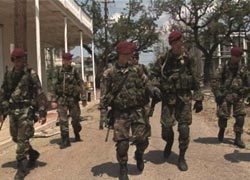
U.S. troops arrive in New Orleans.
"The Cavalry Arrives"
The Times-Picayune reports that 4,600 active duty troops under the command of Gen. Russel Honoré arrive in New Orleans. The situation begins to improve.
An estimated 25,000 angry and exhausted people are still at the Convention Center; buses begin arriving to evacuate them. New Orleans residents are still trapped by the floodwaters, and dispatchers receive about 1,000 emergency phone calls from people needing to be rescued.
FEMA Situation Update:
" …Troops poured in to restore order after almost a week of near-anarchy. ... Having largely emptied the cavernous Superdome, which had become a squalid pit of misery and violence, officials turned their attention to the Convention Center, where people waited to be evacuated as corpses rotted in the streets. The death toll in the city is not known, but the dying continues as people succumb to illness, exhaustion and days without food and water.
"Louis Armstrong International Airport served as a massive clearing house for some of the storm's sickest victims Saturday. Military and Coast Guard helicopters flew a steady stream of evacuees from hospitals and rooftops to the airport southwest of downtown. Inside the four triage tents, medical personnel tended to people who had gone for days without their medication. ...
"With the evacuee situation stabilizing somewhat, and increasing numbers of armed soldiers and police on the streets, officials said Saturday they would start aggressively dealing with the bands of armed looters who pushed the city to the brink of complete breakdown. …"
In Washington, President Bush publicly acknowledges the inadequacy of the federal government's response: "Many of our citizens simply are not getting the help they need, especially in New Orlenas. And that is unacceptable."
Read the full interview »
Richard Falkenrath, Homeland Security Adviser (2001-2004):
"There was a period of days when we weren't sure who was directing the federal response and were all the actions being taken. And the impression given in those four days is basically indelible. And it is injurious to the president. There's no question."
|
|
Day Seven | Sunday, September 4 |
"Search and Rescue Continues"
The Times-Picayune reports the Convention Center evacuees are still being loaded onto buses and evacuated and search-and-rescue operations continue. The Convention Center becomes a destination for walk-in refugees seeking evacuation. About 2,000 medical evacuees remain at Louis Armstrong Airport, which has become a staging area for responders and injured refugees. There are still gangs of armed criminals roaming the city; police and National Guard, now numbered at 16,000, have a better handle on the situation than earlier in the week.
|
|
Day Eight | Monday, September 5 |
"One Week Later"
The Times-Picayune reports that Jefferson Parish residents are allowed to return to the area to inspect the damage to their homes.The breach in the 17th Street Canal is finally repaired, and engineers continue to work on other levee breaks. Some electrical substations serving downtown New Orleans are repaired, but Entergy, the local energy utitlity, must first ensure that buildings can receive the electricity safely before the power is restored.
FEMA Situation Update:
"A week after Hurricane Katrina struck New Orleans ... state officials and the U.S. Army Corps of Engineers say once the canal level is drawn down two feet, Pumping Station 6 can begin pumping water out of the bowl-shaped city. Some parts of the city already showed slipping floodwaters as the repair neared completion, with the low-lying Ninth Ward dropping more than a foot. In downtown New Orleans, some streets were merely wet rather than swamped. … Since many New Orleans streets are still filled with stagnant, fetid waters smelling of garbage and raw sewage, the military was considering using planes to spray for mosquitoes."
|
|
Day Nine | Tuesday, September 6 |
"Total Evacuation"
Mayor Ray Nagin orders the total evacuation of New Orleans due to the dangers posed by the contaminated standing water. He estimates 5,000 to 10,000 people are still in the city, with many of them still waiting to be rescued.
The Times-Picayune reports that the breaches in the 17th Street and Florida Avenue Canals have been repaired and power is restored to the Warehouse and Central Business Districts. Half of telephone service is back.
The Army Corps of Engineers projects it could take 80 days to pump the water out of the city.
|
A final, official tally of those killed in the disaster is still not in. As of Nov. 22, 2005, more than 900 people are known to have died in New Orleans. The vast majority of them were elderly.
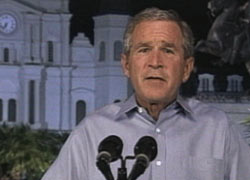
President Bush's Sept. 15th address to the nation.
On Sept. 15, 2005, in an address to the nation, President Bush declares, "It is now clear that a challenge on this scale requires greater federal authority and a broader role for the armed forces -- the institution of our government most capable of massive logistical operations on a moment's notice."
In his speech, he calls on all federal, state and local agencies to review their performance.
Military planners are considering setting up a permanent rapid reaction unit designed to respond to domestic disasters. The price tag has not yet been determined.
|













